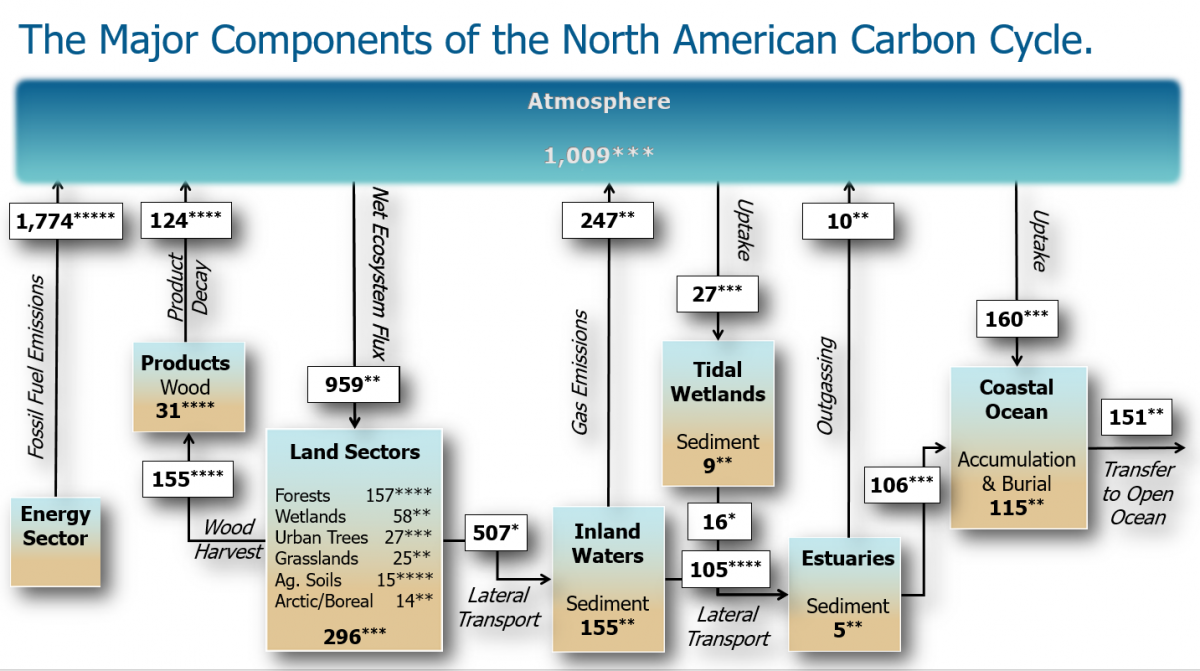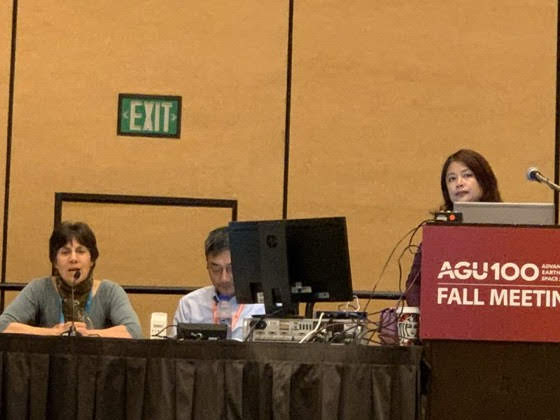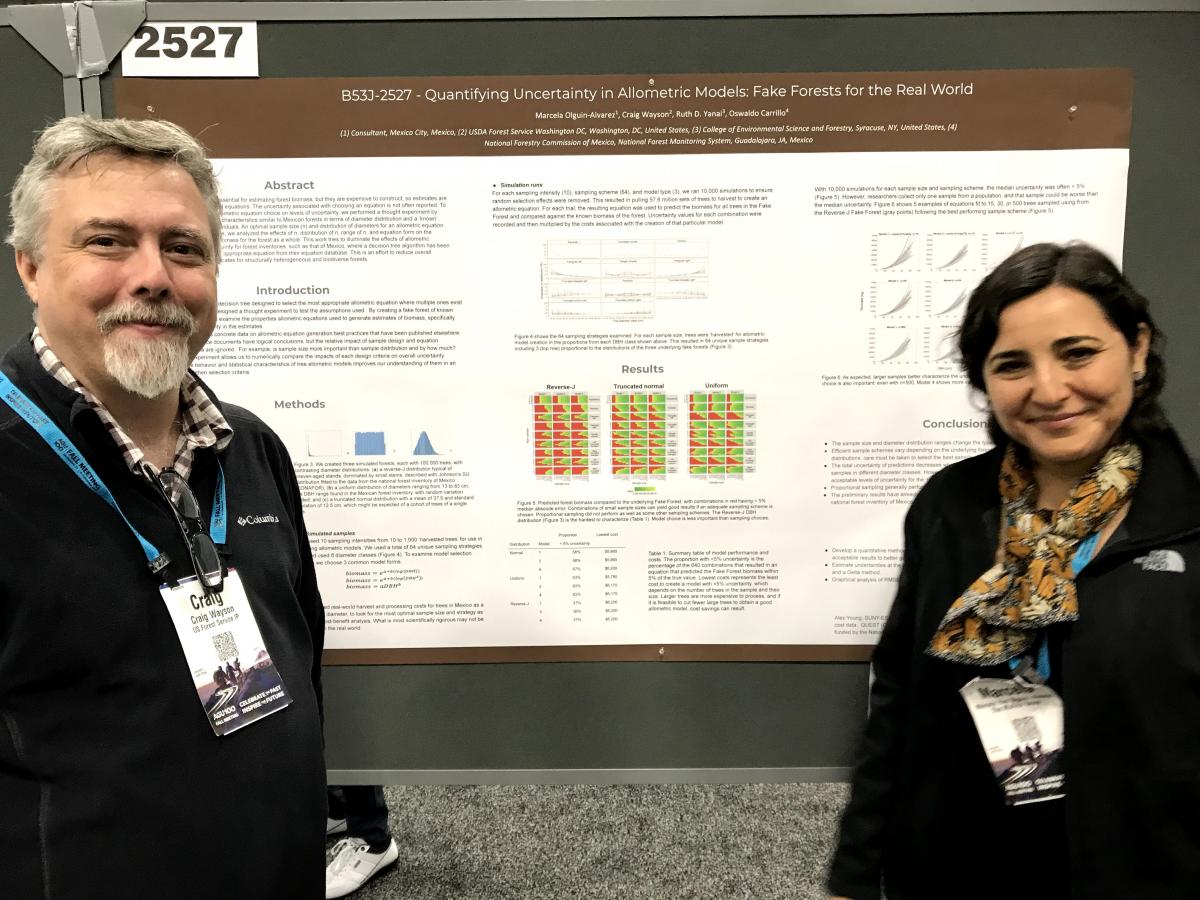- Home
- About
- Programs
- Carbon Science Planning
- Resources
- News & Opportunities
- Contact Us
Carbon Budget, Observations and Coordination Networks: Highlights from AGU Interactions
January 6, 2020
 The U.S. Carbon Cycle Science Program and Carbon Cycle Interagency Working Group (CCIWG) organized a series of activities at the December 9-13, 2020 American Geophysical Union Meetings in San Francisco, California. Multiple presentations* highlighted recent achievements, advances and collaborations of the Program in close coordination with the U.S. and international science community, such as the Second State of the Carbon Cycle Report (SOCCR2) (Click here for SOCCR2 animation of Carbon Budget of North America or on inset image for full presentation animation: Major Components of North American Carbon Cycle / North American Carbon Cycle Budget by Dan Hayes, presented during our AGU session.)
The U.S. Carbon Cycle Science Program and Carbon Cycle Interagency Working Group (CCIWG) organized a series of activities at the December 9-13, 2020 American Geophysical Union Meetings in San Francisco, California. Multiple presentations* highlighted recent achievements, advances and collaborations of the Program in close coordination with the U.S. and international science community, such as the Second State of the Carbon Cycle Report (SOCCR2) (Click here for SOCCR2 animation of Carbon Budget of North America or on inset image for full presentation animation: Major Components of North American Carbon Cycle / North American Carbon Cycle Budget by Dan Hayes, presented during our AGU session.)
John L Campbell, USDA Forest Service, Northern Research Station, Vallejo, CA, United States, Gyami Shrestha, U.S. Carbon Cycle Science Program & UCAR, Washington, DC, United States, Werner Leo Kutsch, ICOS ERIC, Head Office, Helsinki, Finland, Zhiliang Zhu, U.S. Geological Survey, Reston, VA, United States, James H Butler, NOAA, Boulder, CO, United States, Mark B. Green, Plymouth State University, Plymouth, NH, United States, Nancy Cavallaro, USDA/NIFA, Washington, DC, United States and with joint team of U.S. Carbon Cycle Science Program, Carbon Cycle Interagency Working Group and E.U. Integrated Carbon Observation System (ICOS) science communities
Innovations in carbon measurement technologies, platforms and coordinated networks are advancing our ability to understand carbon stores, carbon cycle feedbacks, and the level of threat they pose. For instance, interagency, multi-partner organizations such as the U.S. Carbon Cycle Science Program (CCSP) and the E.U. Integrated Carbon Observation System (ICOS) working with thousands of multi-disciplinary community scientists, produce and use tremendous amounts of high quality data and analyses for understanding, observing and monitoring the carbon cycle. This session highlighted novel data sets, quantitative methods, as well as innovative and emerging partnerships employed in characterizing the carbon cycle, with special attention to understanding the uncertainty in carbon budgets across land, air and water to inform management and policy decisions from local to global scales.

Gyami Shrestha, U.S. Carbon Cycle Science Program & UCAR, Washington, DC, United States, James H Butler, NOAA, Boulder, CO, United States, Paula S Bontempi, NASA Headquarters, Washington, DC, United States, Zhiliang Zhu, U.S. Geological Survey, Reston, VA, United States, Nancy Cavallaro, USDA/NIFA, Washington, DC, United States, Elisabeth K Larson, NASA, Washington, DC, United States and Anne Marsh, USDA Forest Service, Washington, D.C., United States
Representing 14 federal agencies and departments with research and funding portfolio encompassing carbon and pertinent biogeochemical cycles, the U.S. Carbon Cycle Science Program (https://carboncyclescience.us), incorporates broad coordinated community input such as from U.S. Carbon Cycle Science Plans (1999, 2011). Recently, the Program and its leadership, the Carbon Cycle Interagency Working Group or CCIWG (established in 1998), completed the latest State of the Carbon Cycle Report or SOCCR2 (USGCRP 2018) (carbon2018.globalchange.gov), a decadal assessment of carbon cycle science across land, atmosphere, ocean and society in North America, collaborating with over 200 experts. Engaging with AGU attendees (from academia, government, private sector, non-profits etc.) during this town hall, CCIWG Program Managers discussed:
- U.S./North American, European, Asian and other research & observation networks, progress and collaborations in carbon cycle research (inlc. North American Carbon Program, and Ocean Carbon and Biogeochemistry Program);
- Current/future community and interagency collaborations for coordination around pertinent research foci and communities;
- Current/upcoming opportunities, interagency activities and partnerships;
- Future research needs and actions, particularly those that require interagency collaborations;
- After Action Review of SOCCR2 (lessons learned, future needs);
- Future assessment recommendations;
- Feedback from AGU attendees and deliberations on all the above.
References:
Michalak, A. M., R. Jackson, G. Marland, C. Sabine, and Carbon Cycle Science Working Group. 2011. A U.S. Carbon Cycle Science Plan. University Corporation for Atmospheric Research.
Sarmiento, J. L., S. C. Wofsy, and Carbon and Climate Working Group. 1999. A U.S. Carbon Cycle Science Plan, A Report of the Carbon and Climate Working Group for the U.S. Global Change Research Program.
USGCRP. 2018. Second State of the Carbon Cycle Report (SOCCR2): A Sustained Assessment Report [Cavallaro, N., G. Shrestha, R. Birdsey, M. A. Mayes, R. G. Najjar, S. C. Reed, P. Romero-Lankao, and Z. Zhu (eds.)]. U.S. Global Change Research Program, Washington, DC, USA, 878 pp., https://doi.org/10.7930/SOCCR2.2018.
4. North American Carbon Program (NACP) Strategic Plan Town Hall (Town hall)
Christopher A Williams, Clark University, Graduate School of Geography, Worcester, MA, United States, Elisabeth K Larson, NASA, Washington, DC, United States, Gyami Shrestha, U.S. Carbon Cycle Science Program & UCAR, Washington, DC, United States, Natasha MacBean, University of Arizona, Tucson, AZ, United States, Arlyn E Andrews, NOAA/ESRL, Global Monitoring Division, Boulder, CO, United States, Eric T Sundquist, USGS, Woods Hole, MA, United States, Kenneth J Davis, The Pennsylvania State University, Department of Meteorology and Atmospheric Science, University Park, PA, United States and Molly Elizabeth Brown, University of Maryland, Greenbelt, MD, United States
The North American Carbon Program (NACP) serves as an essential venue for coordinated carbon cycle science research across North America, including measurement and research concerning terrestrial and coastal ocean carbon fluxes, their importance as sources and sinks of atmospheric greenhouse gases (primarily CO2 and CH4), and the extent to which they are affected by natural processes and human activities. Since its initiation in 2002, new findings, new capabilities, and new research foci have emerged. Building on findings and recommendations from Second State of the Carbon Cycle Report (SOCCR2), the NACP community is currently developing a new strategic plan (the NACP Science Implementation Plan) that re-articulates the program’s goals and offers a vision for implementation. This session provided an open forum to discuss the aims and implementation strategies designed to deliver the next generation of the NACP.
---------------------

*Presented Talks
B51E-01 Top-down constraints on the North American carbon cycle from the North American Carbon Program (Invited) Arlyn E Andrews, NOAA/ESRL, Global Monitoring Division, Boulder, CO, United States and Lori Bruhwiler, NOAA, ESRL/GMD, Boulder, CO, United States
B51E-02 A convergence among estimates of a large North American carbon sink: linkages across bottom-up, top-down and sideways data sets Daniel J Hayes, University of Maine, School of Forest Resources, Orono, ME, United States, Rodrigo Vargas, University of Delaware, Newark, DE, United States, David E Butman, Yale University, Hamden, CT, United States, Andrew R Jacobson, NOAA Boulder, Boulder, CO, United States and Richard Birdsey, Woods Hole Research Center, Woods Hole, United States
B51E-03 Perspectives on Top-Down Carbon Flux Estimates: How Do We Make Progress? Lori Bruhwiler, NOAA Boulder, Boulder, CO, United States
B51E-04 Data usage practices and network design for in-situ atmospheric carbon cycle observations revisited Alexander T Vermeulen1,2, Ute Karstens3, Guillaume Monteil3 and Wouter Peters4, (1)Lund University, Physical geography and Ecosystem science, Lund, Sweden, (2)ICOS ERIC, Carbon Portal, Lund, Sweden, (3)Lund University, Lund, Sweden, (4)Wageningen University, Wageningen, Netherlands
B51E-05 NASA’s Carbon Cycle and Ecosystems Focus Area Jack A Kaye1, Kathy A Hibbard2, Hank A Margolis3, Kenneth W Jucks4, Laura Lorenzoni1, Garik Gutman5, William W Turner6 and Paula S Bontempi1, (1)NASA Headquarters, Washington, DC, United States, (2)Pacific Northwest National Laboratory, Atmospheric Sciences & Global Change, Richland, WA, United States, (3)NASA Headquarters, Washington, United States, (4)NASA HQ, Washington, DC, United States, (5)NASA Headquarters, International, Washington, WA, United States, (6)NASA Headquarters, Washington DC, DC, United States
B51E-06 Uncertainty in Measurements of Trees in the US Forest Service Forest Inventory and Analysis (FIA) Program. Ruth D. Yanai1, John L Campbell2, Alexander Young1, Gretchen A. Dillon1, Mark B. Green3, Charles J Barnett4, Grant M Domke5 and Christopher W Woodall4, (1)SUNY College of Environmental Science and Forestry, Syracuse, NY, United States, (2)USDA Forest Service, Northern Research Station, Vallejo, CA, United States, (3)Case Western Reserve University, Department of Earth, Environmental, and Planetary Sciences, Cleveland, OH, United States, (4)USDA Forest Service, Northern Research Station, Durham, NH, United States, (5)USDA Forest Service, Northern Research Station, St. Paul, MN, United States
B51E-07 Correcting Errors in Error Propagation for REDD+ Carbon Accounting Craig Wayson, USDA Forest Service Washington DC, Washington, DC, United States, Ruth D. Yanai, SUNY College of Environmental Science and Forestry, Syracuse, NY, United States, James W Kirchner, ETH Swiss Federal Institute of Technology Zurich, Department of Environmental Systems Science, Zurich, Switzerland, Andrew Lister, USFS, Newtown Square, United States, John L Campbell, USDA Forest Service, Northern Research Station, Vallejo, CA, United States, Mark Green, Case Western Reserve University, Cleveland, OH, United States and John E Drake, ESF-Suny, Syracuse, United States
B51E-08 Detecting and accounting for allometric variation in trees: Implications for quantifying forest recovery (Invited) John Battles, University of California Berkeley, Berkeley, CA, United States, Jacob Levine, Princeton University, Princeton, United States, Joseph Battles, University of Chicago, Chicago, United States and Perry de Valpine, University of California Berkeley, Berkeley, United States
B51E-09 How to Estimate Statistically Detectable Trends in a Time Series: A Study of Soil Carbon and Nutrient Concentrations at the Calhoun LTSE (Invited) Daniel deB. Richter Jr1, Megan L. Mobley2, Yang Yang3, Kevin A. Nelson4, Allan R Bacon5 and Paul Heine1, (1)Duke University, Nicholas School of the Environment, Durham, NC, United States, (2)Oregon State University, Corvallis, United States, (3)University of California Merced, Merced, United States, (4)Unaffiliated, Syracuse, United States, (5)University of Florida, School of Forest Resources and Conservation, Ft Walton Beach, FL, United States
B51E-10 Impacts of the 2018 drought in Europe: a multi-scale perspective from in-situ, remote-sensing and modelling datasets (Invited) Ana Bastos1, Michel Ramonet2, Dario Papale3, Ingrid Theodora van der Laan-Luijkx4, Naomi Smith4, Markus Reichstein5, Ulrich Weber5, Philippe Ciais2, Wouter Peters6 and Werner Leo Kutsch7, (1)Ludwig Maximilians University of Munich, Dept. of Geography, Munich, Germany, (2)LSCE Laboratoire des Sciences du Climat et de l'Environnement, Gif-Sur-Yvette Cedex, France, (3)University of Tuscia, Department for Innovation in Biological, Agro-food and Forest systems (DIBAF), Viterbo, Italy, (4)Wageningen University and Research, Wageningen, Netherlands, (5)Max Planck Institute for Biogeochemistry, Department of Biogeochemical Integration, Jena, Germany, (6)Wageningen University, Wageningen, Netherlands, (7)ICOS ERIC, Head Office, Helsinki, Finland
B51E-11 Innovation and engineering for industrial-scale negative emissions systems David Babson, Zara L'Heureux and Gregory Thiel, U.S. Department of Energy, Advanced Research Projects Agency - Energy, Washington, DC, United States
B51E-12 Monitoring urban greenhouse gas emissions: Lessons from the NIST greenhouse gas measurements test-bed program Kenneth J Davis1, Thomas Lauvaux2, Natasha Miles1, Scott Richardson3, Paul Shepson4, Jocelyn C Turnbull5, Riley M Duren6, Kevin R Gurney7, Ralph F Keeling8, Jooil Kim9, Charles E Miller10, Kristal R Verhulst11, Ray F Weiss8, Vineet Yadav6, Sharon Gourdji12, Anna Karion12, Israel Lopez-Coto12, Subhomoy Ghosh12, Kimberly L Mueller13 and James R Whetstone12, (1)Pennsylvania State University Main Campus, University Park, PA, United States, (2)Pennsylvania State University Main Campus, Department of Meteorology and Atmospheric Science, University Park, PA, United States, (3)Pennsylvania State University, State College, PA, United States, (4)Stony Brook University, Stony Brook, NY, United States, (5)GNS Science, Lower Hutt, New Zealand, (6)Jet Propulsion Laboratory, Pasadena, CA, United States, (7)Arizona State University, Tempe, AZ, United States, (8)Univ California San Diego, La Jolla, CA, United States, (9)Scripps Institution of Oceanography, La Jolla, CA, United States, (10)Jet Propulsion Lab, Pasadena, CA, United States, (11)UC Irvine, Irvine, CA, United States, (12)National Institute of Standards and Technology Gaithersburg, Gaithersburg, MD, United States, (13)University of Michigan EWRE, Washington, DC, United States
**Presented Posters
B53J-2520 Scaling boundaries in Science: A North American Carbon Cycle Example Gyami Shrestha, U.S. Carbon Cycle Science Program & UCAR, Washington, DC, United States, Elisabeth K Larson, NASA, Washington, DC, United States, Christopher A Williams, Clark University, Graduate School of Geography, Worcester, MA, United States, Andrew M Fox, University of Arizona, School of Natural Resources and the Environment, Tucson, AZ, United States and U.S. Carbon Cycle Science Program and North American Carbon Program Science Teams
B53J-2522 Habitat conservation to protect carbon resources in the United States: how science and land management work together Zhiliang Zhu1, Scott Covington2, Kurt Johnson2 and Beth Middleton3, (1)U.S. Geological Survey, Reston, VA, United States, (2)U.S. Fish and Wildlife Service, Falls Church, VA, United States, (3)U.S. Geological Survey, Lafayette, VA, United States
B53J-2523 Underestimation of Vegetation Carbon Storage in Aging Forests by Earth System Models Chen Zhu, East China Normal University, Shanghai, China and Jianyang Xia, School of Ecological and Environmental Sciences, East China Normal University, Shanghai, China
B53J-2524 Using ICESat-2 and Landsat to map forest carbon pools with associated uncertainty: A multivariate geostatistical modeling approach Chad Babcock1, Andrew O Finley2,3, Grant M Domke4, Douglas C Morton5 and Bruce Cook5, (1)University of Minnesota Twin Cities, Department of Forest Resources, St. Paul, MN, United States, (2)USDA Forest Service Pacific Northwest Research Station, Seattle, WA, United States, (3)Michigan State University, Departments of Forestry and Geography, East Lansing, MI, United States, (4)US Forest Service, Northern Research Station, St. Paul, MN, United States, (5)NASA Goddard Space Flight Center, Greenbelt, MD, United States
B53J-2525 Harmonized Global Maps of Above and Belowground Biomass Carbon Density in the Year 2010 Seth Spawn1, Clare C Sullivan1, Tyler J Lark2 and Holly Gibbs3, (1)University of Wisconsin Madison, Geography, Madison, WI, United States, (2)University of Wisconsin - Madison, Center for Sustainability and the Global Environment (SAGE), Nelson Institute for Environmental Studies, Madison, WI, United States, (3)University of Wisconsin Madison, Department of Geography; Center for Sustainability and the Global Environment (SAGE), Nelson Institute for Environmental Studies, Madison, WI, United States
B53J-2526 Soil carbon data and networks for resilience and mitigation of climate change Nancy Cavallaro, USDA Washington DC, Washington, DC, United States and Jennifer W Harden, Stanford University, Stanford, CA, United States
B53J-2527 Quantifying Uncertainty in Allometric Models: Fake Forests for the Real World Marcela Itzel Olguin-Alvarez, Consultant, Mexico City, Mexico, Craig Wayson, USDA Forest Service Washington DC, Washington, DC, United States, Ruth D. Yanai, SUNY College of Environmental Science and Forestry, Syracuse, NY, United States and Oswaldo Ismael Carrillo, National Forestry Commission of Mexico, National Forest Monitoring System, Guadalajara, JA, Mexico

B53J-2528 Carbon allocation in Australian forests and woodlands by combining terrestrial observations with remote sensing-based models Mathias Neumann, Swinburne University of Technology, Hawthorn, VIC, Australia
B53J-2529 Assessing different sampling methods to develop forest carbon budgets Kim Gerard Mattson, Ecosystems Northwest, Mount Shasta, CA, United States and Jianwei Zhang, US Forest Service, Pacific Southwest Research Station, Redding, CA, United States
B53J-2530 Comparison of Carbon Budget of Shrub-Steppe and Agricultural Soils in Central Washington, USA Carey Alice Gazisand Brandon Kautzman, Central Washington University, Ellensburg, WA, United States
B53J-2531 Effects of soil properties on neutron scattering techniques for soil carbon measurement William Larsen1,2, Mauricio Ayllon Unzueta2,3, Eoin Brodie4, Cristina Castanha5, Charles Gary6, Craig Brown6, Bernhard Ludewigt2, Caitlin Hicks Pries7, Andrew Rosenstrom2,8 and Arun Persaud2, (1)Rice University, Earth, Environmental and Planetary Sciences, Houston, TX, United States, (2)Lawrence Berkeley National Laboratory, Accelerator Technology and Applied Physics Division, Berkeley, CA, United States, (3)University of California Berkeley, Nuclear Engineering, Berkeley, CA, United States, (4)Lawrence Berkeley National Laboratory, Earth and Environmental Sciences, Berkeley, CA, United States, (5)Lawrence Berkeley National Laboratory, Berkeley, CA, United States, (6)Adelphi Technology Inc., Redwood City, CA, United States, (7)Dartmouth College Life Sciences Center, room 349 78, Hanover, NH, United States, (8)Texas A&M University College Station, Nuclear Engineering, College Station, CA, United States
B53J-2532 Uncertainty in rates of urban forest carbon storage for Baltimore, MD and Syracuse, NY Alexander Young1, Ruth D. Yanai1, Randal Eblacker1 and Dave Nowak2, (1)SUNY College of Environmental Science and Forestry, Syracuse, NY, United States, (2)US Forest Service Newtown Square, Newtown Square, PA, United States
B53J-2533 Integrating Imaging Spectroscopy, Eddy Flux and Ground-based Vegetation Measurements to Assess Relationships Between Gross and Net Primary Productivity in Northern Forests Ting Zheng, University of Toronto, Toronto, ON, Canada; University of Wisconsin - Madison, Forest and Wildlife Ecology, Madison, United States, Philip A Townsend, University of Wisconsin, Department of Forest and Wildlife Ecology, Madison, WI, United States, Eric L Kruger, University of Wisconsin-Madison, Department of Forest and Wildlife Ecology, Madison, WI, United States and Ankur R Desai, University of Wisconsin Madison, Department of Atmospheric and Oceanic Sciences, Madison, WI, United States
B53J-2534 Methods of inorganic carbon removal from aridisols: Implications for quantifying organic carbon pools in arid ecosystems Kelsey Holbrook Jensen, Cornell University, Ithaca, NY, United States and Jed P Sparks, Cornell University, Ecology and Evolutionary Biology, Ithaca, United States
B53J-2535 Modeled Vs Measured NPP: Are Global Satellite Estimates of Forest NPP Appropriate Across the Terrain of Northern Rocky Mountain Forests? Jeralyn M Poe1, Jeffrey Stenzel2, Nuria Sanchez Lopez3, Luigi Boschetti4 and Tara W Hudiburg2, (1)Michigan State University, East Lansing, MI, United States, (2)University of Idaho, Department of Forest, Rangeland, and Fire Sciences, Moscow, ID, United States, (3)Wageningen, Netherlands, (4)University of Idaho, Department of Forest, Rangeland and Fire Sciences, Moscow, ID, United States
B53J-2536 Toward an improved estimate of the carbon pool in coarse woody debris and its representation in Earth system models Nicole Hemming-Schroeder, Irvine, CA, United States, Steven D Allison, University of California Irvine, Ecology & Evolutionary Biology, Irvine, CA, United States and James Tremper Randerson, University of California Irvine, Department of Earth System Science, Irvine, CA, United States
We thank everyone for your participation and collaboration!

